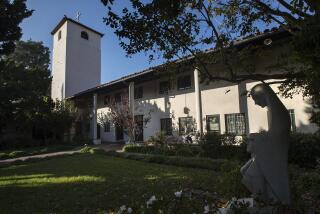Tibetan Monastery Emerges From Ravages of Communism
- Share via
ZHONGDIAN, China — Thirty-two years ago, the Tibetans of Zhongdian county tore down their 300-year-old Buddhist monastery to meet Mao Tse-tung’s radical cry for a communist new order.
Now, with their own hands and money, they are undoing the destruction that ideology wrought.
For 14 years, they have labored to resurrect Gedan Songzan monastery from the ruins of charred beams and broken mud walls scattered over the wind-swept hillock outside Zhongdian town, in China’s southwestern Yunnan province. They will probably need seven more years.
“Our monastery was destroyed. Now it’s up to us to rebuild it,” said Luosang Nibu, a 26-year-old farmer, as he planed pine boards outside a half-built dormitory for monks from his Little Zhongdian village, 10 miles to the south.
Luosang left his family’s five-acre farm with its horses and yaks to spend two months this spring building the dormitory. Little Zhongdian’s wealthy logging-truck drivers donated funds for construction. Luosang worked for free.
“This is my contribution to religion,” he said.
Day after day, modest farmers like Luosang and a few paid day laborers saw planks, pack walls of mud and rock and erect columns for dormitories and prayer halls. Elderly monks, their bodies gnarled from years of forced labor when religion was outlawed, shovel dirt alongside novices in their teens.
The monastery’s mammoth main prayer hall with its towering white walls and golden roof rises three stories from the hill’s crest, shadowing two other large temples. Eight dormitories to house about 500 monks stand in various stages of progress.
The monastery was once the largest in Diqing, a trio of Tibetan-dominated counties lying across broad valleys sloping from peaks of more than 18,000 feet off Tibet’s southeastern edge. Gedan Songzan had links to the great monasteries of Lhasa, ruled by the Dalai Lama, and drew the patronage of China’s Kangxi emperor in the 17th century. More than 2,000 monks studied under as many as 17 scholarly lamas.
Then, in late 1966, local officials enforcing Mao’s call for a radical reshaping of society, a “Cultural Revolution,” ordered Gedan Songzan torn down. Every village was forced to send workers to help in the two-week dismantling. Zealous crowds beat the monks. One learned lama died from his injuries.
Tibetans did not get permission to rebuild Gedan Songzan until 1984. Since then, the county government has set aside $360,000 for repairs. Local people have contributed three times that much.
“The government isn’t giving enough money. All this comes from the people,” said Luozang Nangpo, the 52-year-old master carpenter overseeing the reconstruction. He learned his carpentry in secret during the Cultural Revolution from a master temple builder.
“This temple is something that has existed for hundreds of years, not just a few decades,” said Luozang. “Not rebuilding it was inconceivable.”
More to Read
Sign up for Essential California
The most important California stories and recommendations in your inbox every morning.
You may occasionally receive promotional content from the Los Angeles Times.










